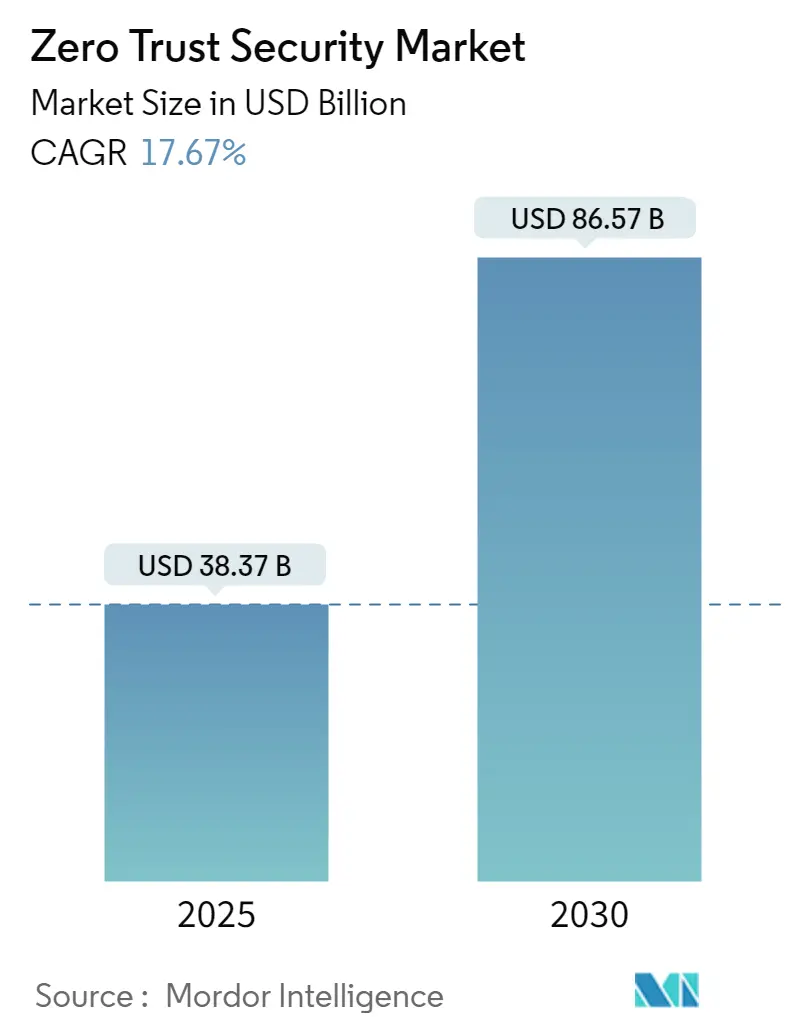
| Study Period | 2019 - 2030 |
| Market Size (2025) | USD 38.37 Billion |
| Market Size (2030) | USD 86.57 Billion |
| CAGR (2025 - 2030) | 17.67 % |
| Fastest Growing Market | Asia Pacific |
| Largest Market | North America |
| Market Concentration | Low |
Major Players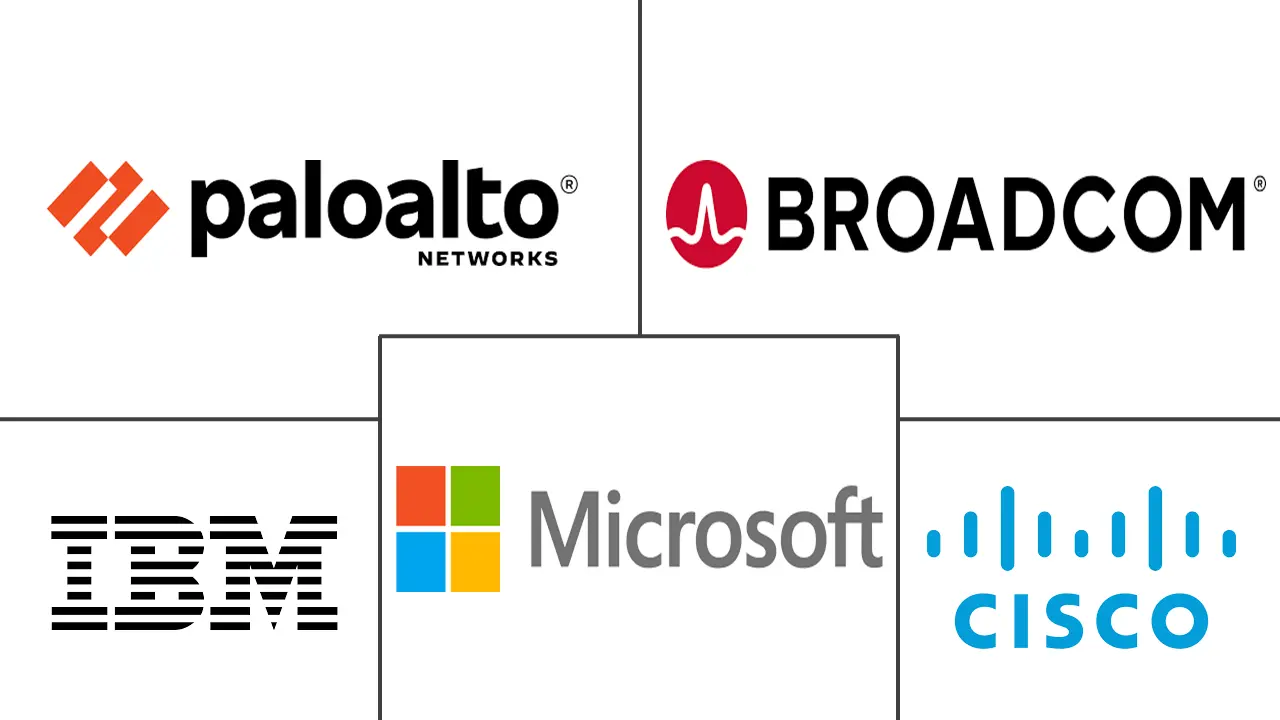
*Disclaimer: Major Players sorted in no particular order |
Zero Trust Security Market Analysis
The Zero Trust Security Market size is estimated at USD 38.37 billion in 2025, and is expected to reach USD 86.57 billion by 2030, at a CAGR of 17.67% during the forecast period (2025-2030).
The zero trust security landscape is experiencing a fundamental transformation as organizations rapidly embrace cloud-first strategies and digital transformation initiatives. According to Zscaler's State of Zero Trust Transformation 2023 report, approximately 90% of businesses migrating to the cloud are adopting zero trust security principles. This shift is particularly evident in the financial sector, where institutions are prioritizing security measures while balancing the need for enhanced customer experience. The integration of zero trust principles with cloud security has become essential as organizations move away from traditional perimeter-based security models to more dynamic, identity-based approaches.
Enterprise security architectures are evolving to address the complexities of multi-cloud environments and distributed workforces. According to Fortinet's 2023 State of Zero Trust Report, 66% of surveyed companies are currently employing solutions as part of their zero trust strategies to minimize breach impacts, marking a significant increase from previous years. Major technology providers are expanding their offerings to meet these emerging needs, as evidenced by Microsoft's July 2023 expansion of its Entra platform with new Security Service Edge capabilities, including Internet Access and Private Access solutions.
The European market is witnessing substantial investment in zero trust security market initiatives, with IDC reporting a 10.6% growth in European security spending for 2023. This trend is reflected in strategic partnerships and solution launches, such as AccuKnox's September 2023 collaboration with IXEL SA to provide Zero Trust Cloud Native Application Protection Platform solutions across Europe. The finance sector leads this investment surge, driven by regulatory compliance requirements and the need to protect increasingly complex digital infrastructure.
The Asia-Pacific region is emerging as a crucial market for zero trust security solutions, with significant developments in enterprise adoption and vendor partnerships. In August 2023, Singtel announced a groundbreaking partnership with Zscaler to offer comprehensive cybersecurity solutions across Asia, marking a first for the region. This collaboration demonstrates the growing recognition of zero trust architectures as essential components of modern cybersecurity strategies. According to recent industry surveys, 96% of Indian IT leaders who have initiated cloud migration have either implemented or are planning to implement zero trust security architecture, indicating strong regional momentum in adoption.
Zero Trust Security Market Trends
Increasing Number of Data Breaches
The escalating frequency and sophistication of data breaches have become a primary catalyst for zero trust security adoption across industries. According to IBM's 2022 X-Force Threat Intelligence Report, the global economic impact of cyberattacks is projected to reach USD 50 billion in losses by 2024. The manufacturing sector has emerged as particularly vulnerable, accounting for 23% of ransomware attacks, with 61% of breach attempts targeting operational technology systems essential to manufacturing operations.
The financial sector faces particularly severe challenges, as evidenced by recent high-profile incidents. According to Sophos Ltd's 2022 survey of 444 financial services professionals, more than 55% of organizations were hit by ransomware in 2021-2022, with 55% documenting an increase in attack volume and 64% reporting increased attack sophistication. The rising threat landscape has prompted organizations to implement more robust network security measures, with zero trust emerging as a crucial strategy for preventing unauthorized access and limiting the potential impact of breaches.
Security Perimeter of an Organization Not Being Limited to Workplace
The traditional concept of organizational security perimeters has been fundamentally transformed by the widespread adoption of remote work and cloud security services. According to Bankrate LLC's July 2023 Economic Indicator poll, 64% of the U.S. full-time workforce prefers fully remote work, while 68% favor hybrid arrangements over entirely in-person appointments. This shift has created a complex security challenge as organizations must protect data and resources accessed from various locations and devices.
The expansion of cloud services and distributed networks has necessitated a more sophisticated approach to network security. Organizations are increasingly exchanging access to networks and data with third-party vendors and partners, creating additional risks that require a stricter approach to access security. Zero trust security addresses these challenges by assuming that no user or device, regardless of their location or network, can be trusted by default. The solution focuses on continuous monitoring and verification of user and device behavior, with access privileges strictly limited to the minimum required for employees and other parties to perform their duties. This approach has become particularly crucial as businesses operate in hybrid or multi-cloud environments, where data and applications are distributed across different cloud service providers and on-site infrastructure.
Segment Analysis: By Deployment
On-premise Segment in Zero Trust Security Market
The on-premise deployment segment continues to dominate the zero trust security market, commanding approximately 63% of the market share in 2024. This significant market position is driven by organizations' need for greater data control, lower latency, and enhanced customization options compared to cloud implementations. Small and medium enterprises (SMEs) are leading the adoption of on-premise zero trust network security solutions, particularly implementing zero trust network access (ZTNA) services to ensure authenticated identity-based access while minimizing application exposure to the internet. The segment's strength is further reinforced by the ability to enable zero trust network access on-premises, creating surgical and brokered connections between authorized local users and specific applications, thereby preventing lateral access across the network and minimizing risk. Various IT and Telecom enterprises are implementing zero-trust strategies to securely and seamlessly access any application, including on-premises web-based applications, enabling digitally empowered employees to become more productive with freedom of access from anywhere at any time.
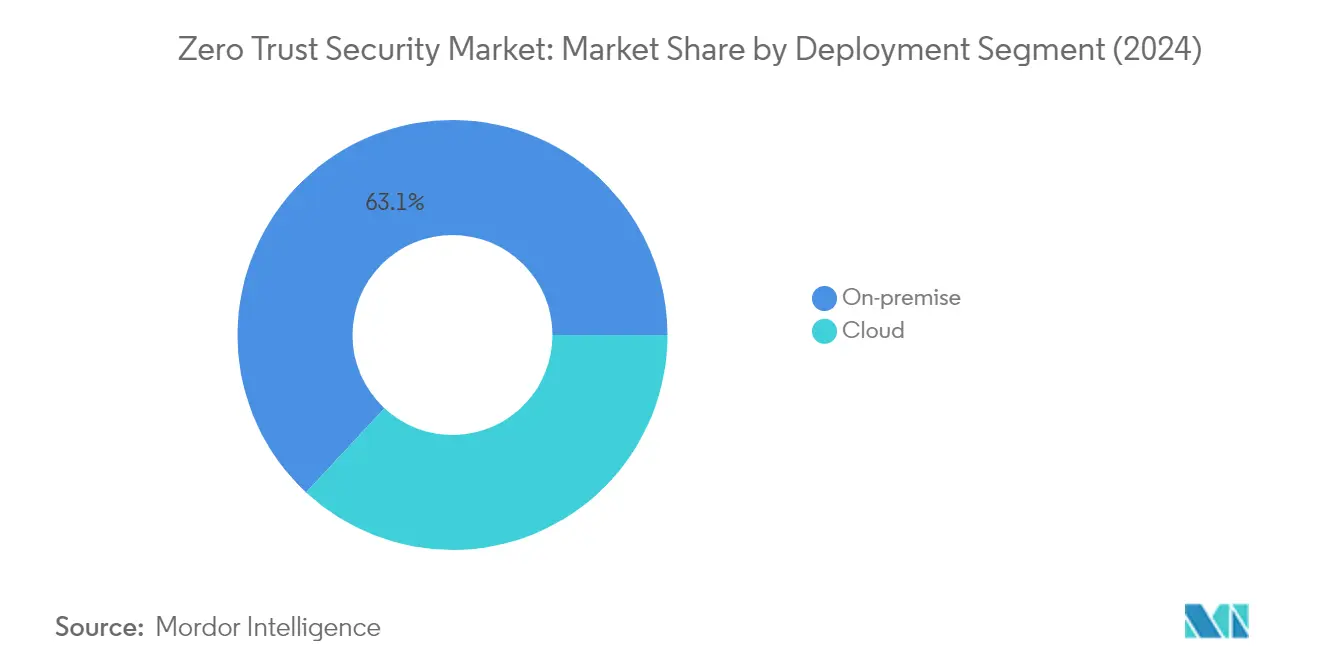
Cloud Segment in Zero Trust Security Market
The cloud deployment segment is experiencing rapid growth and is projected to expand at approximately 18% CAGR during 2024-2029. This accelerated growth is primarily attributed to the increasing adoption of cloud computing across enterprises seeking enhanced business agility and operational efficiency. The COVID-19 pandemic has been a strong catalyst for investment in cloud technology, compelling organizations to adopt multi-cloud strategies for achieving the flexibility and scalability needed for new working models. Cloud-based zero trust network security solution integrations with cloud-based applications are gaining traction due to their ability to secure remote connections with minimal latency for end-users. As the modern workforce and workloads rapidly migrate to the cloud, cybercriminals are moving beyond traditional malware attacks, putting tremendous pressure on IT security teams. The steady increase in adopting cloud-based applications has left businesses struggling to protect hybrid workers and enterprise assets, driving the demand for cloud-based zero trust security solutions.
Segment Analysis: By Organization Size
Large Enterprises Segment in Zero Trust Security Market
Large enterprises continue to dominate the zero trust security market, commanding approximately 66% market share in 2024. This dominance is primarily driven by these organizations' substantial IT infrastructure investments and their pressing need to protect vast amounts of sensitive data across multiple locations and devices. Large enterprises are increasingly adopting cloud computing solutions, with many striving to migrate more than half of their digital workloads to the cloud by 2025. The implementation of zero trust architecture security has become a critical strategy for these organizations as they deal with complex hybrid environments, multiple cloud platforms, and geographically dispersed workforces. Major corporations across various sectors, particularly in banking, healthcare, and technology, are leading the adoption of zero trust architectures to protect their extensive digital assets and maintain compliance with evolving regulatory requirements. The segment's growth is further supported by these organizations' substantial cybersecurity budgets and their ability to implement comprehensive security solutions across their entire digital infrastructure.
SME Segment in Zero Trust Security Market
The Small and Medium Enterprises (SME) segment is experiencing rapid growth in the zero trust security market, with an expected growth rate of approximately 18% during the forecast period 2024-2029. This accelerated growth is driven by the increasing recognition among SMEs that traditional security approaches are insufficient to protect against modern cyber threats. According to the World Economic Forum, SMEs represent 90% of all global businesses and nearly 70% of international jobs and GDP, making them critical drivers of innovation and economic growth. The segment's growth is further fueled by the availability of more affordable and scalable cloud-based zero trust solutions specifically designed for smaller organizations. SMEs are increasingly adopting hybrid work models and cloud services, necessitating more robust security measures that can protect their distributed workforce and digital assets. The rise of managed security service providers offering zero trust solution providers as a service has made these sophisticated security solutions more accessible to SMEs, enabling them to implement enterprise-grade security measures despite having limited internal IT resources.
Segment Analysis: By End-User Industry
BFSI Segment in Zero Trust Security Market
The Banking, Financial Services, and Insurance (BFSI) segment maintains its dominant position in the zero trust security market, commanding approximately 22% of the market share in 2024. This leadership position is driven by the sector's increasing exposure to sophisticated cyber threats and the critical nature of financial data protection. The International Monetary Fund highlights that financial and technological interconnections within the BFSI sector facilitate the rapid spread of cyberattacks, causing widespread disruption throughout the entire financial ecosystem. The adoption of cloud computing and digital transformation initiatives in the banking sector has further accelerated the need for robust zero trust architecture security solutions. Financial institutions are increasingly implementing multi-factor authentication, role-based access controls, and continuous authentication mechanisms to ensure that only permitted users can access critical data and assets. The sector's focus on regulatory compliance and data protection requirements has made zero trust security solutions an essential component of their cybersecurity strategy.
Healthcare Segment in Zero Trust Security Market
The healthcare segment is emerging as the fastest-growing sector in the zero trust security market, with projections indicating robust growth from 2024 to 2029. The rapid digitization of healthcare services, coupled with the increasing adoption of telehealth solutions and connected medical devices, is driving this exceptional growth trajectory. Healthcare organizations are particularly vulnerable to cyberattacks due to the high value of patient data and the critical nature of their operations. The sector's adoption of cloud-based health information systems and the proliferation of Internet of Medical Things (IoMT) devices has created a complex security landscape that demands sophisticated zero trust solutions. Major cybersecurity vendors are developing specialized zero trust security solutions specifically designed for healthcare organizations, focusing on protecting electronic health records, ensuring HIPAA compliance, and securing connected medical devices. The integration of zero trust principles in healthcare environments is becoming increasingly critical as organizations balance the need for seamless access to patient data with robust security measures.
Remaining Segments in End-User Industry
The zero trust security market encompasses several other significant segments, including IT and Telecom, Manufacturing, Retail, Government, and Energy and Power sectors. The IT and Telecom sector is particularly focused on securing cloud infrastructure and protecting sensitive customer data, while the Manufacturing sector is prioritizing the security of industrial IoT devices and operational technology networks. The Government sector is implementing network segmentation security to protect critical infrastructure and sensitive national security information. The Retail sector is focusing on securing e-commerce platforms and protecting customer payment data, while the Energy and Power sector is implementing zero trust solutions to protect critical infrastructure from increasingly sophisticated cyber threats. Each of these sectors brings unique security requirements and challenges to the market, contributing to the overall growth and evolution of zero trust security solutions.
Zero Trust Security Market Geography Segment Analysis
Zero Trust Security Market in North America
North America continues to dominate the global zero trust security market landscape, commanding approximately 39% of the market share in 2024. The region's leadership position is primarily driven by the United States, which demonstrates a significant inclination towards implementing and accepting advanced technology, particularly in network automation and cloud security services. The presence of prominent market vendors like Cisco Systems, IBM Corporation, VMware Inc., and Palo Alto Networks further strengthens the region's market position. The U.S. federal government's aggressive push toward zero trust network access implementation, coupled with the growing adoption of hybrid and remote work models, has created a robust demand for comprehensive enterprise security solutions. Industries such as banking, healthcare, and government organizations, which maintain sensitive information databases, are increasingly prioritizing zero-trust frameworks to protect against sophisticated cyber threats. The region's rapid adoption of new technologies and growing focus on security-as-a-service continues to drive market growth, particularly in areas requiring robust cloud intrusion protection and network security market solutions.
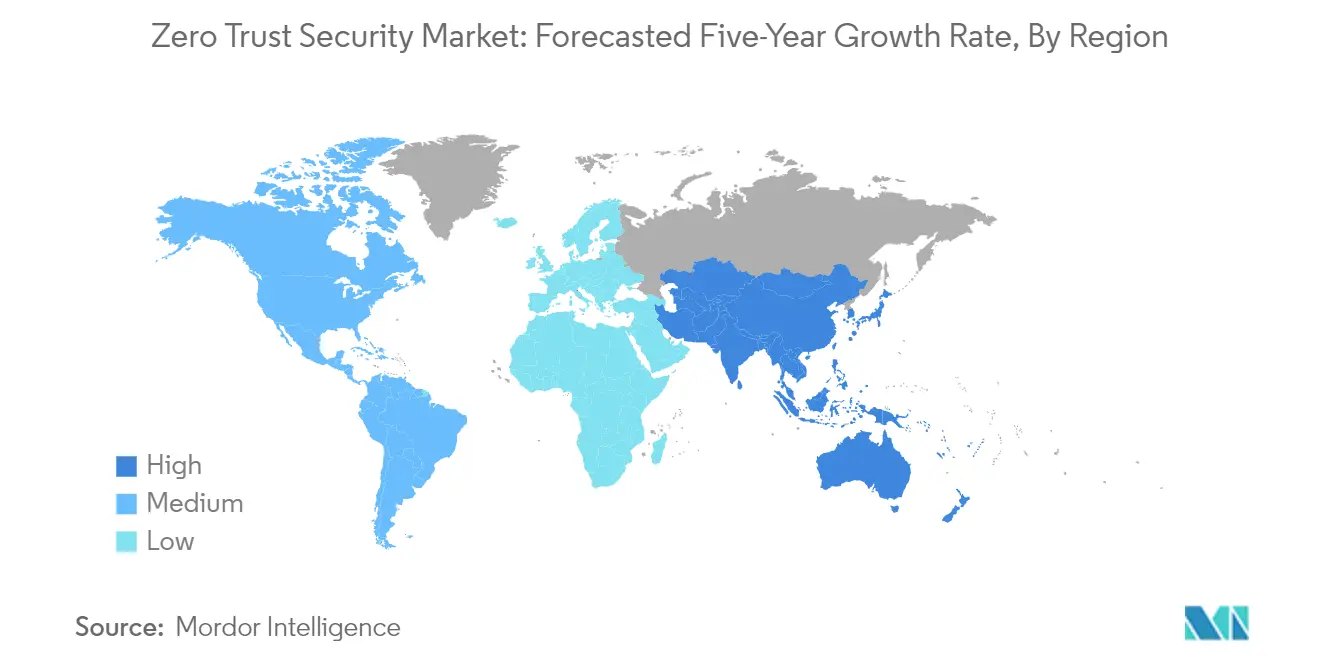
Zero Trust Security Market in Europe
The European zero trust security industry has demonstrated remarkable resilience and growth, experiencing approximately 17% growth during the period 2019-2024. The region's market dynamics are significantly influenced by Germany, the UK, and France, which collectively account for over half of the European security market. The finance sector maintains the highest spending on security solutions, driven by stringent regulatory compliance requirements and the need for enhanced data security. European organizations are increasingly reviewing their cyber resilience strategies to ensure robust cyber hygiene practices, with senior management actively supporting new investments and initiatives in zero trust network access. The region's manufacturing and government sectors follow closely behind finance in terms of security spending, with manufacturing focusing on protecting industrial assets and government sectors emphasizing data protection and digital transformation initiatives. The increasing adoption of cloud services and the growing complexity of cyber threats have made zero trust security a strategic priority for European businesses.
Zero Trust Security Market in Asia Pacific
The Asia Pacific zero trust security market is positioned for exceptional growth, with projections indicating approximately a 19% growth rate for the period 2024-2029. The region's market expansion is primarily fueled by rapid digital transformation across various industries, particularly in countries like China and India. The increasing adoption of cloud computing and the proliferation of connected devices have created a pressing need for robust security frameworks. Organizations across the region are actively embracing zero trust principles as they modernize their IT infrastructure and respond to evolving cyber threats. The manufacturing sector, particularly strong in this region, is driving significant demand for zero trust solutions as companies seek to protect their industrial assets and intellectual property. The rise of hybrid cloud deployments and the increasing sophistication of cyber threats have made zero trust security an essential component of organizational security strategies across the Asia Pacific region.
Zero Trust Security Market in Rest of the World
The Rest of the World region, encompassing the Middle East, Africa, and Latin America, is experiencing significant transformation in its approach to cybersecurity. Organizations in these regions are increasingly recognizing the importance of zero trust security frameworks as they accelerate their digital transformation initiatives. Latin American organizations, in particular, are focusing on breach containment technologies and zero trust segmentation to prepare for and mitigate potential security breaches. The Middle East's energy sector, being a critical infrastructure component, is driving substantial demand for zero trust security solutions. The region's growing focus on smart city initiatives and digital government services has created additional momentum for zero trust adoption. African nations are gradually developing their cybersecurity infrastructure, with an increasing number of organizations moving away from traditional perimeter-based security approaches to more sophisticated zero trust frameworks.
Zero Trust Security Market Overview
Top Companies in Zero Trust Security Market
The zero trust security solutions market features prominent technology leaders, including Cisco Systems, Palo Alto Networks, VMware, Microsoft, IBM, Google, and Broadcom (Symantec), among others. These zero trust companies are driving innovation through the continuous development of AI-powered security solutions, cloud-native platforms, and advanced authentication mechanisms. Strategic moves in the industry are characterized by significant investments in research and development to enhance existing product portfolios while developing new capabilities in areas like endpoint security, network access control, and data protection. Companies are increasingly focusing on delivering comprehensive security frameworks that integrate multiple solutions, from identity management to threat detection, under unified platforms. Operational agility is demonstrated through rapid deployment capabilities, flexible subscription models, and enhanced customer support services. Market expansion strategies include strategic partnerships with cloud service providers, managed security service providers, and system integrators to extend market reach and technological capabilities.
Dynamic Market Structure Drives Competitive Evolution
The zero trust market exhibits a complex competitive structure characterized by both global technology conglomerates and specialized zero trust security vendors. Large technology companies leverage their extensive resources, established customer relationships, and integrated product ecosystems to maintain market dominance, while specialized providers compete through focused innovation and deep expertise in specific security domains. The market shows moderate consolidation, with larger players actively pursuing strategic acquisitions to enhance their technological capabilities and expand their solution portfolios, particularly in areas like cloud security, identity management, and endpoint protection.
Market dynamics are shaped by increasing collaboration between vendors, with partnerships becoming crucial for delivering end-to-end security solutions. Merger and acquisition activities are primarily focused on acquiring innovative startups with specialized technologies in areas such as artificial intelligence, machine learning, and automated threat response. Regional players are emerging as significant competitors in specific geographical markets, leveraging their understanding of local regulatory requirements and customer needs. The competitive landscape is further influenced by the growing trend of security vendors integrating their solutions with major cloud platforms and enterprise systems to provide seamless security coverage across hybrid environments.
Innovation and Adaptability Drive Market Success
Success in the zero trust security market increasingly depends on vendors' ability to deliver comprehensive, scalable solutions while maintaining technological leadership. Incumbent providers must focus on continuous innovation in areas such as artificial intelligence-driven threat detection, automated response capabilities, and seamless integration across multiple platforms and environments. Market leaders are strengthening their positions through enhanced customer support, professional services, and managed security offerings, while also maintaining strong partnerships with cloud providers and system integrators. The ability to provide flexible deployment options, including hybrid and multi-cloud implementations, while ensuring consistent security policies across all environments, has become crucial for maintaining market share.
For emerging contenders, success lies in identifying and addressing specific market gaps or underserved segments while building strong technological differentiation. Companies must navigate complex regulatory requirements across different regions while maintaining compliance with evolving data protection standards. The market shows relatively high end-user concentration in sectors like banking, healthcare, and government, making industry-specific expertise and compliance capabilities crucial success factors. Vendors must also address the growing demand for simplified security management and reduced operational complexity while maintaining robust protection against evolving threats. The ability to demonstrate clear return on investment and tangible security improvements has become increasingly important in winning and retaining customers.
Zero Trust Security Market Leaders
-
Cisco Systems Inc.
-
Palo Alto Networks, Inc.
-
Broadcom Inc. (Symantec Corporation)
-
Microsoft Corporation
-
IBM Corporation
- *Disclaimer: Major Players sorted in no particular order
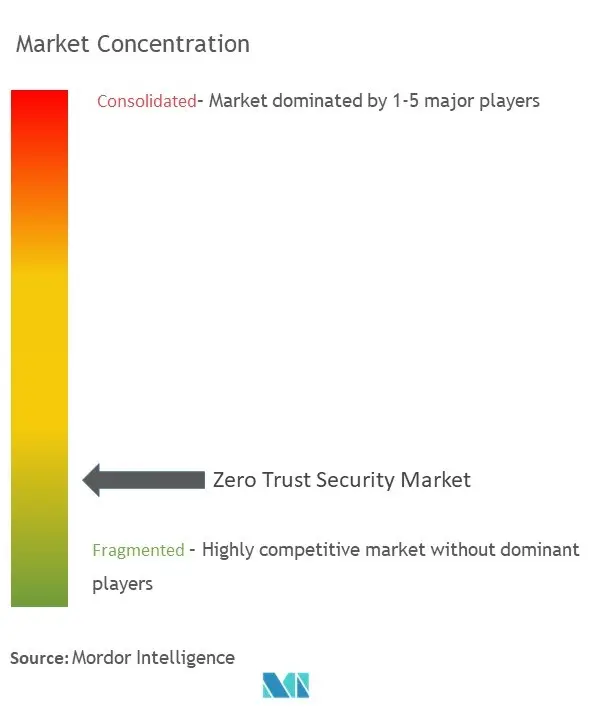
Zero Trust Security Market News
- July 2023: Microsoft Entra expanded into Security Service Edge with two new offerings. The company announced two new products, Microsoft Entra Internet Access and Microsoft Entra Private Access. This cloud service provides flexibility and ease of use. It proves cost-effective compared to legacy on-prem systems so that users don't have to sacrifice productivity to achieve the best security controls available. The principles of Zero Trust are used to build this model, where the system helps verify each identity and uses a risk-based context so that users only have access to the applications, resources, or destinations they need for their work.
- June 2023: Cisco Systems CSCO expanded its security portfolio by launching a new security service edge (SSE) solution, which provides an efficient hybrid working environment and simplifies access across any location, device, and application. To enable hybrid work in a secure environment, Cisco has introduced a new SSE solution, Cisco Secure Access, which offers seamless access to all applications. The solution makes it easier to operate security operations by integrating multiple functions in a single, easily usable solution that ensures the protection of all traffic.
Zero Trust Security Market Report - Table of Contents
1. INTRODUCTION
- 1.1 Study Assumptions and Market Definition
- 1.2 Scope of the Study
2. RESEARCH METHODOLOGY
3. EXECUTIVE SUMMARY
4. MARKET INSIGHTS
- 4.1 Market Overview
-
4.2 Industry Attractiveness - Porter's Five Forces Analysis
- 4.2.1 Bargaining Power of Suppliers
- 4.2.2 Bargaining Power of Buyers
- 4.2.3 Threat of New Entrants
- 4.2.4 Threat of Substitutes
- 4.2.5 Intensity of Competitive Rivalry
- 4.3 Impact of COVID-19
- 4.4 Industry Value Chain Analysis
-
4.5 Technology Snapshot
- 4.5.1 Zero Trust Networks
- 4.5.2 Zero Trust Devices
- 4.5.3 Zero Trust Data
- 4.5.4 Zero Trust Identities
- 4.5.5 Zero Trust Applications (Visibility and Analytics)
5. MARKET DYNAMICS
-
5.1 Market Drivers
- 5.1.1 Increasing Number of Data Breaches
- 5.1.2 Security Perimeter of an Organization not Being Limited to Workplace
-
5.2 Market Restraints
- 5.2.1 Legacy Applications, Infrastructure, and Operating Systems Not Likely to Adopt Zero Trust Model
6. MARKET SEGMENTATION
-
6.1 By Deployment
- 6.1.1 On-premise
- 6.1.2 Cloud
-
6.2 By Organization Size
- 6.2.1 Small and Medium Enterprises
- 6.2.2 Large Enterprises
-
6.3 By End-user Industry
- 6.3.1 IT and Telecom
- 6.3.2 BFSI
- 6.3.3 Manufacturing
- 6.3.4 Healthcare
- 6.3.5 Energy and Power
- 6.3.6 Retail
- 6.3.7 Government
- 6.3.8 Other End-user Industries
-
6.4 By Geography***
- 6.4.1 North America
- 6.4.2 Europe
- 6.4.3 Asia
- 6.4.4 Australia and New Zealand
- 6.4.5 Latin America
- 6.4.6 Middle East and Africa
7. COMPETITIVE LANDSCAPE
-
7.1 Company Profiles*
- 7.1.1 Cisco Systems Inc.
- 7.1.2 Palo Alto Networks Inc.
- 7.1.3 Broadcom Inc. (Symantec Corporation)
- 7.1.4 Microsoft Corporation
- 7.1.5 IBM Corporation
- 7.1.6 Google Inc.
- 7.1.7 Check Point Software Technologies Ltd
- 7.1.8 Blackberry Limited
- 7.1.9 Akamai Technologies Inc.
- 7.1.10 Delinea (Centrify Corporation)
- 7.1.11 Okta Inc.
- 7.1.12 Fortinet Inc.
- 7.1.13 Sophos Group PLC
- 7.1.14 Cyxtera Technologies Inc.
8. INVESTMENT ANALYSIS
9. FUTURE OF THE MARKET
Zero Trust Security Market Industry Segmentation
The market is defined by the revenue generated from zero-trust security solutions offered by various players operating in the market. The study also tracks the key market factors that encapsulate new entrants and major vendors working in the industry landscape, which supports market estimations and growth trends during the forecast period.
The zero trust security is segmented by deployment type (on-premise and cloud), organization size (small and medium enterprises and large enterprises), end-user industry (IT and telecom, BFSI, manufacturing, healthcare, energy and power, retail, government, and other end-user industries), and geography (North America, Europe, Asia, Australia and New Zealand, Latin America, and Middle East and Africa). The market size and forecasts are provided in terms of value (USD) for all the above segments.
| By Deployment | On-premise |
| Cloud | |
| By Organization Size | Small and Medium Enterprises |
| Large Enterprises | |
| By End-user Industry | IT and Telecom |
| BFSI | |
| Manufacturing | |
| Healthcare | |
| Energy and Power | |
| Retail | |
| Government | |
| Other End-user Industries | |
| By Geography*** | North America |
| Europe | |
| Asia | |
| Australia and New Zealand | |
| Latin America | |
| Middle East and Africa |
Zero Trust Security Market Research FAQs
How big is the Zero Trust Security Market?
The Zero Trust Security Market size is expected to reach USD 38.37 billion in 2025 and grow at a CAGR of 17.67% to reach USD 86.57 billion by 2030.
What is the current Zero Trust Security Market size?
In 2025, the Zero Trust Security Market size is expected to reach USD 38.37 billion.
Who are the key players in Zero Trust Security Market?
Cisco Systems Inc., Palo Alto Networks, Inc., Broadcom Inc. (Symantec Corporation), Microsoft Corporation and IBM Corporation are the major companies operating in the Zero Trust Security Market.
Which is the fastest growing region in Zero Trust Security Market?
Asia Pacific is estimated to grow at the highest CAGR over the forecast period (2025-2030).
Which region has the biggest share in Zero Trust Security Market?
In 2025, the North America accounts for the largest market share in Zero Trust Security Market.
What years does this Zero Trust Security Market cover, and what was the market size in 2024?
In 2024, the Zero Trust Security Market size was estimated at USD 31.59 billion. The report covers the Zero Trust Security Market historical market size for years: 2019, 2020, 2021, 2022, 2023 and 2024. The report also forecasts the Zero Trust Security Market size for years: 2025, 2026, 2027, 2028, 2029 and 2030.
Our Best Selling Reports
Zero Trust Security Market Research
Mordor Intelligence provides comprehensive industry analysis and market research on the zero trust security market, offering detailed insights into market trends, competitive landscape, and growth opportunities. Our research methodology combines extensive primary and secondary research, leveraging relationships with key zero trust security companies and industry stakeholders to deliver accurate zero trust security market size projections and strategic insights. The report pdf includes in-depth analysis of emerging technologies like secure access service edge (SASE), zero trust network access, and network segmentation security, along with detailed market segmentation by component, deployment mode, organization size, and end-user industry.
Our consulting expertise extends beyond traditional market research to provide strategic guidance in the rapidly evolving cybersecurity industry. We assist organizations in developing robust zero trust architecture security frameworks through technology scouting, competition assessment, and regulatory compliance analysis. Our team specializes in analyzing customer needs and behavior patterns in the network security market, helping businesses optimize their zero trust security solutions implementation. We also provide comprehensive assessments of zero trust vendors and zero trust solution providers, supporting clients in partner selection and go-to-market strategy development. Through B2B surveys and data analytics, we help stakeholders understand the dynamics of cloud security adoption and identity verification trends, ensuring informed decision-making in this critical security domain.




